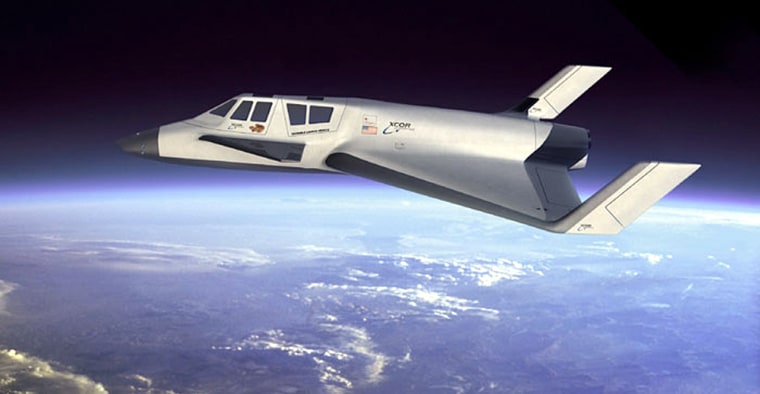During an impromptu ceremony, the Federal Aviation Administration on Friday handed California-based XCOR Aerospace the second launch license ever issued for a manned suborbital rocket plane.
The license represents another significant step toward an era when regular citizens will be able to buy their way into suborbital space, at a cost of tens of thousands of dollars per seat.
Friday's federal go-ahead follows up on the precedent set April 1, when the FAA's Office of Commercial Space Transportation issued a license to Scaled Composites — like XCOR, based in Mojave, Calif. — for its SpaceShipOne rocket plane. That license enabled SpaceShipOne to expand its testing in hopes of winning the $10 million X Prize this year.
XCOR's tests are aimed at the eventual development of a rocket plane called the Xerus, which would take off and land horizontally, like an airplane, but reach altitudes above 62 miles (100 kilometers). At that height, pilots and passengers could experience weightlessness and survey the curving Earth beneath the blackness of space.
Long-term strategy
XCOR is not competing for the $10 million prize, which is currently due to expire at the end of this year. Instead, the company is following a business strategy that will take more time to reach fruition, Jeff Greason, Xcor's president and chief executive officer, told MSNBC.com.
"To make money has always been our goal," he said.
He said the license issued Friday advances that goal by confirming the design approach for XCOR's Sphinx test vehicle and assuring investors that the project is on track. But XCOR's testing routine won't change immediately: In order for the FAA-sanctioned tests to begin, XCOR's takeoff site at Mojave's airport will have to be licensed as well. (Scaled Composites' tests don't require a launch site license because SpaceShipOne is launched from a carrier airplane in midflight.)
George Nield, the FAA's deputy associate administrator for commercial space transportation, said Mojave's launch site application was being processed, and he spoke as if it was just a matter of time before the agency would give its OK.
Surprise ceremony
Nield handed XCOR's license to Greason and colleagues as a sly footnote to his address to the Space Access '04 Conference here in Phoenix. As he was about to step off the stage, he turned back and said he had brought with him "a very rare document — only one other similar document exists in the world."
"It represents a lot of work, blood, sweat and tears," Nield said. He then called the Xcor attendees to the front of the room and presented them with the license as the rest of the crowd applauded.
Friday was the last day of a federally mandated 180-day review period for XCOR's application, so some observers suspected that an announcement might be in the works. Greason said he received word that the news would be positive only the night before.
Long road ahead
The license permits up to 35 test missions of the Sphinx, to be completed between now and the end of 2006. Greason told MSNBC.com that XCOR might have to seek further approval for additional test flights, but he did not expect that task to be as onerous as the one just completed.
The Sphinx would not fly into outer space itself, but it would test the technologies for a spaceworthy Xerus craft. The license does not cover flights for paying passengers, though it does allow for revenue payload flights after initial tests are completed.
Greason said he was "relieved" to complete the initial licensing process, and he hoped the cooperative approach taken by his company and the FAA will set the stage for many other companies to win licenses in the future.
"I hope that this is the second of many," he said.
The initial version of this report incorrectly implied that the Sphinx test vehicle would fly into space.
